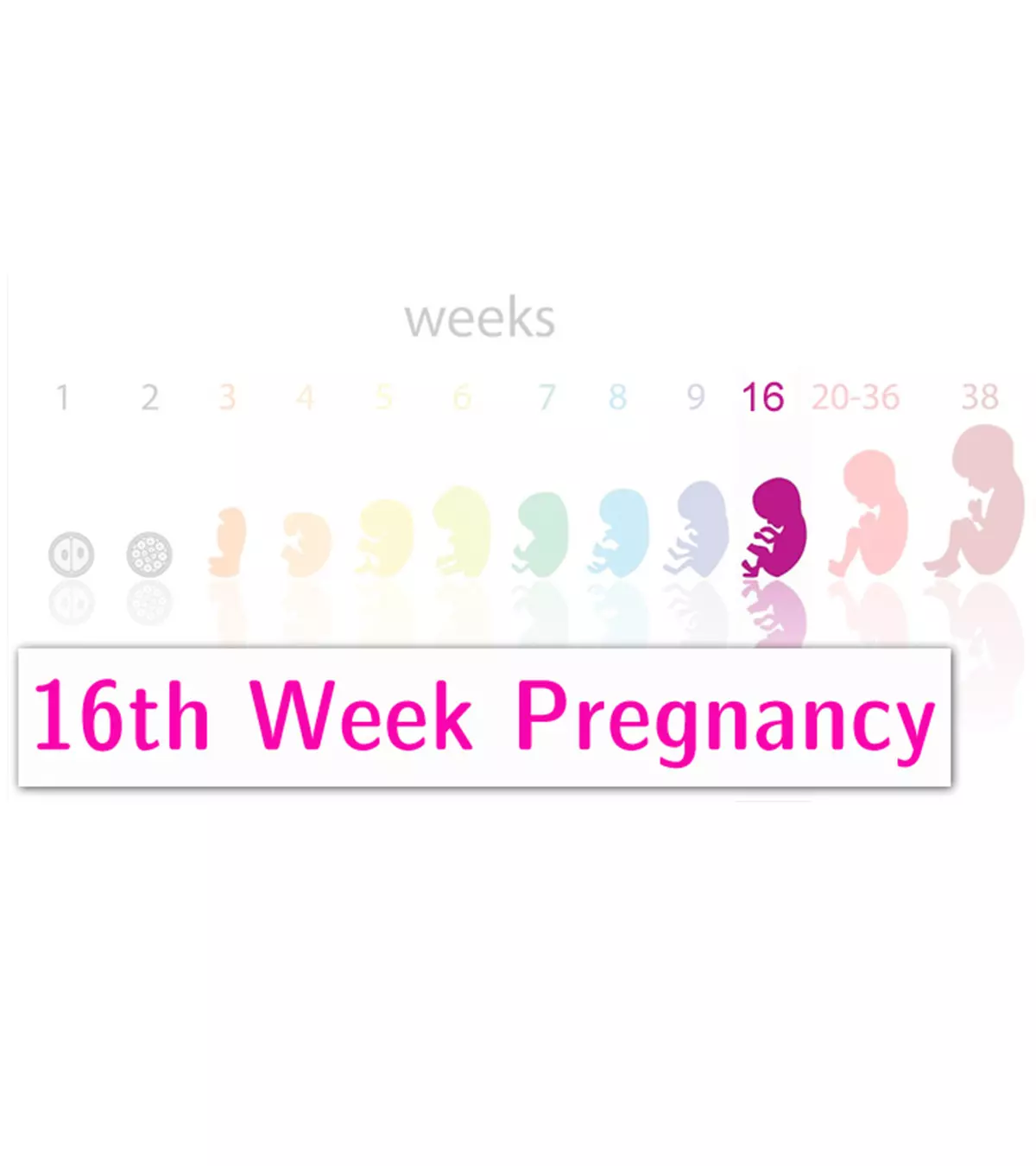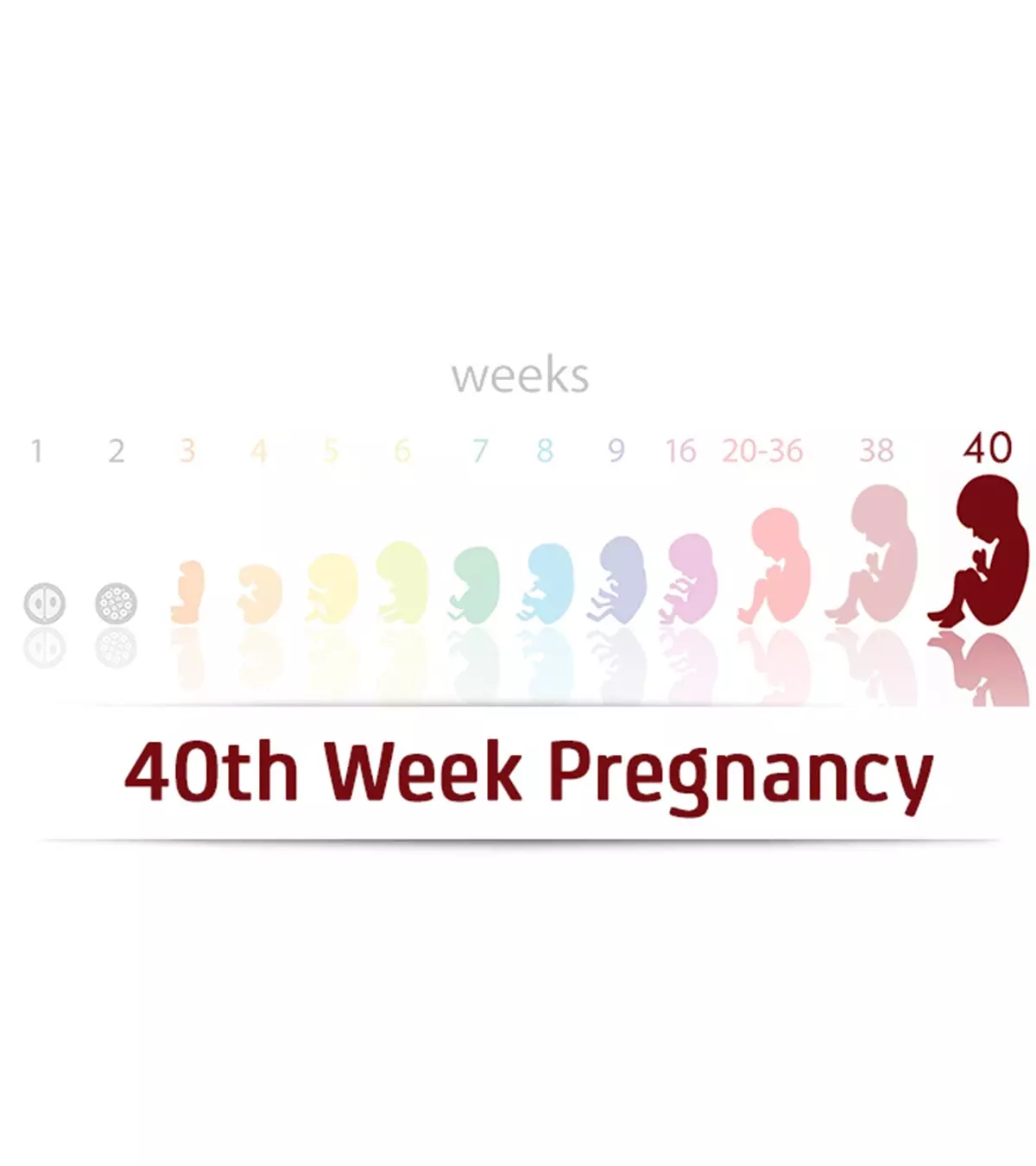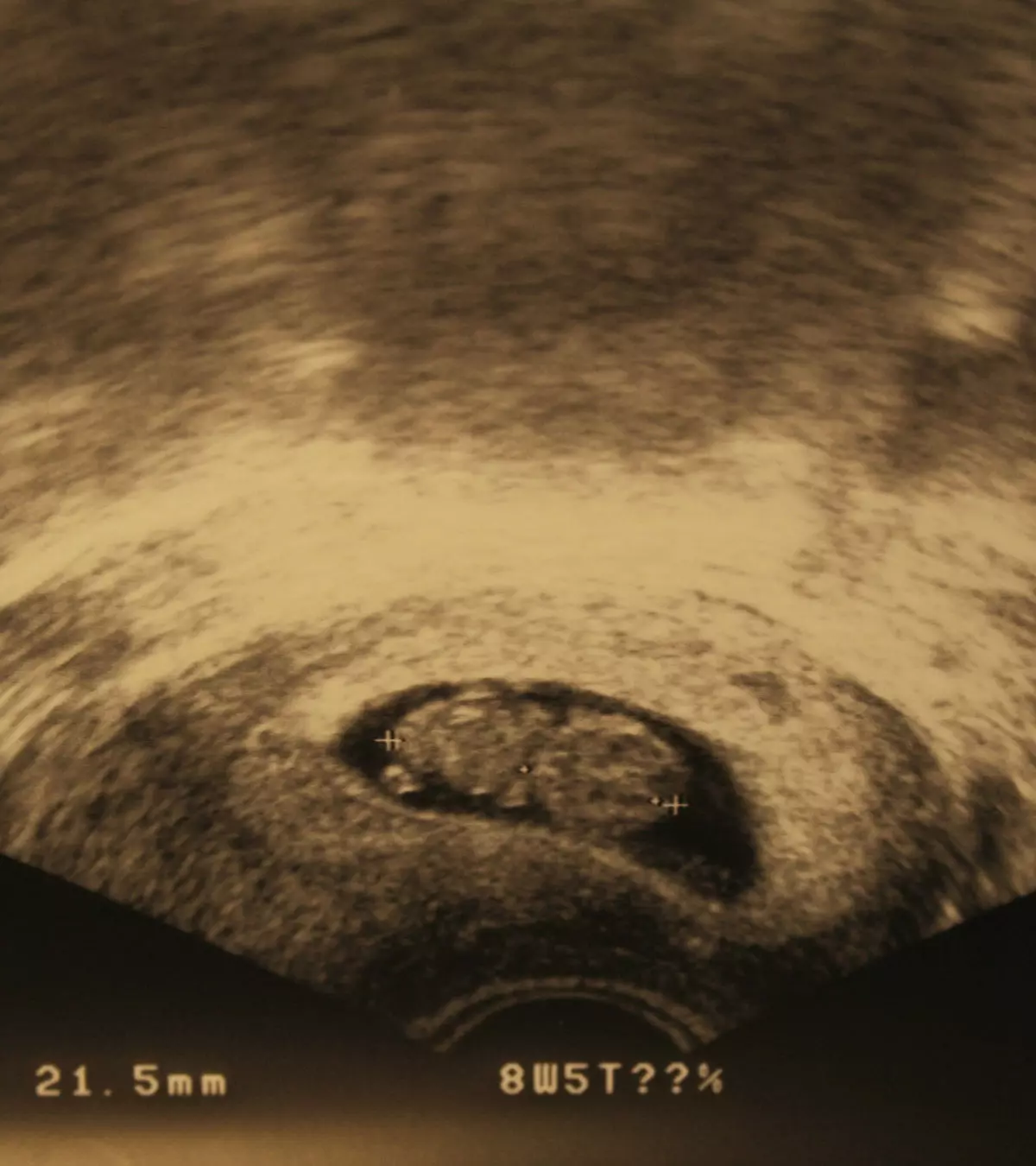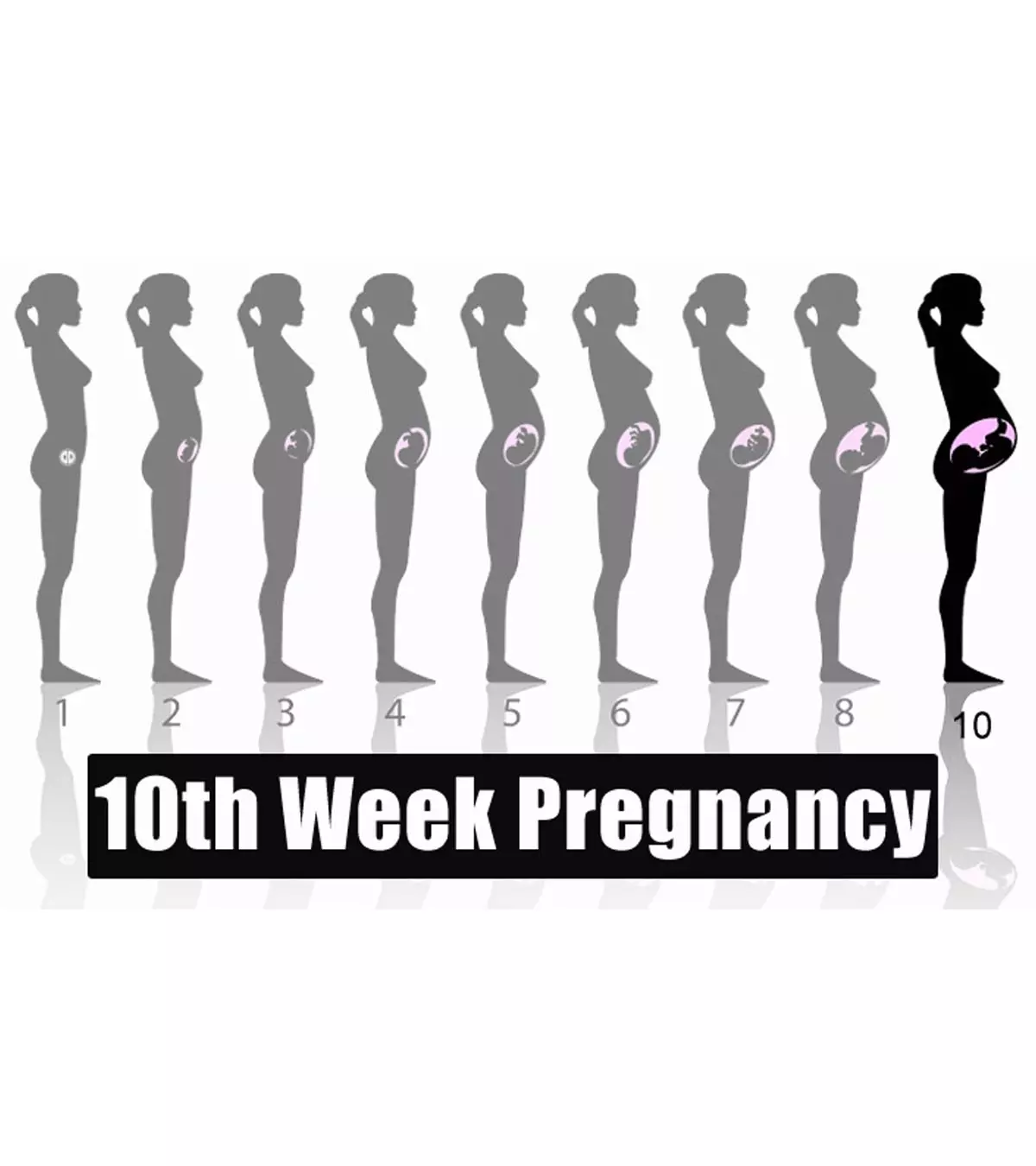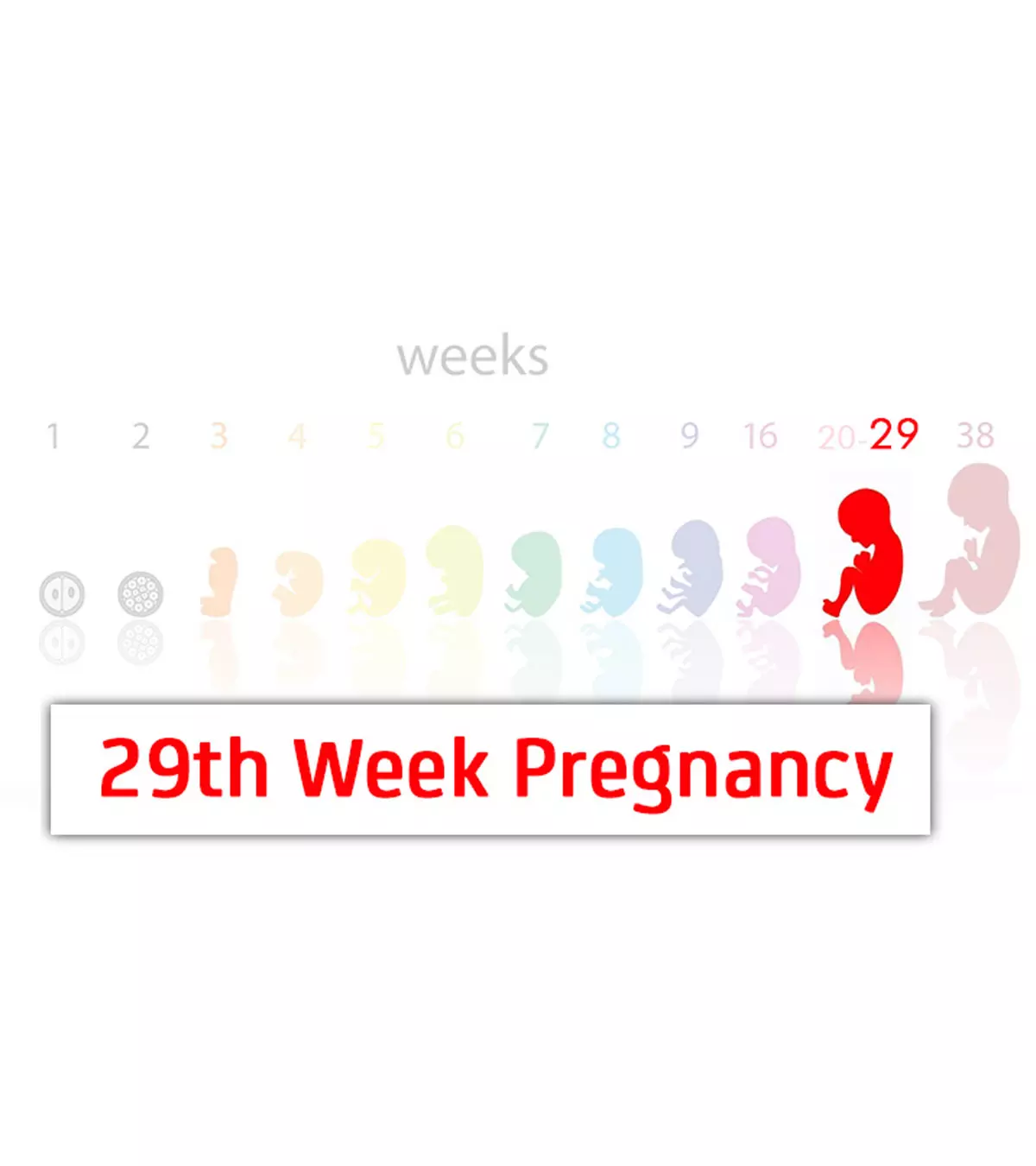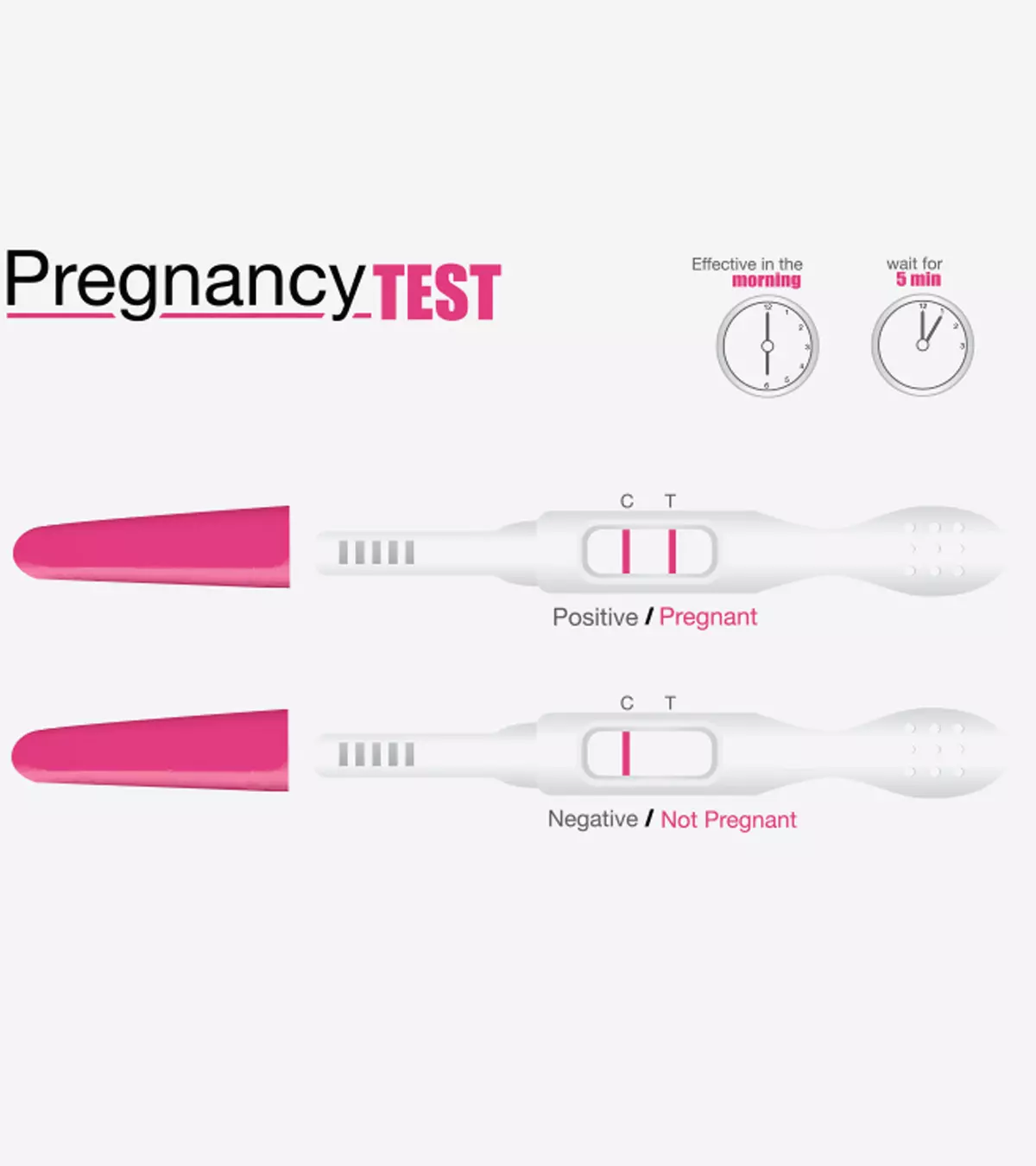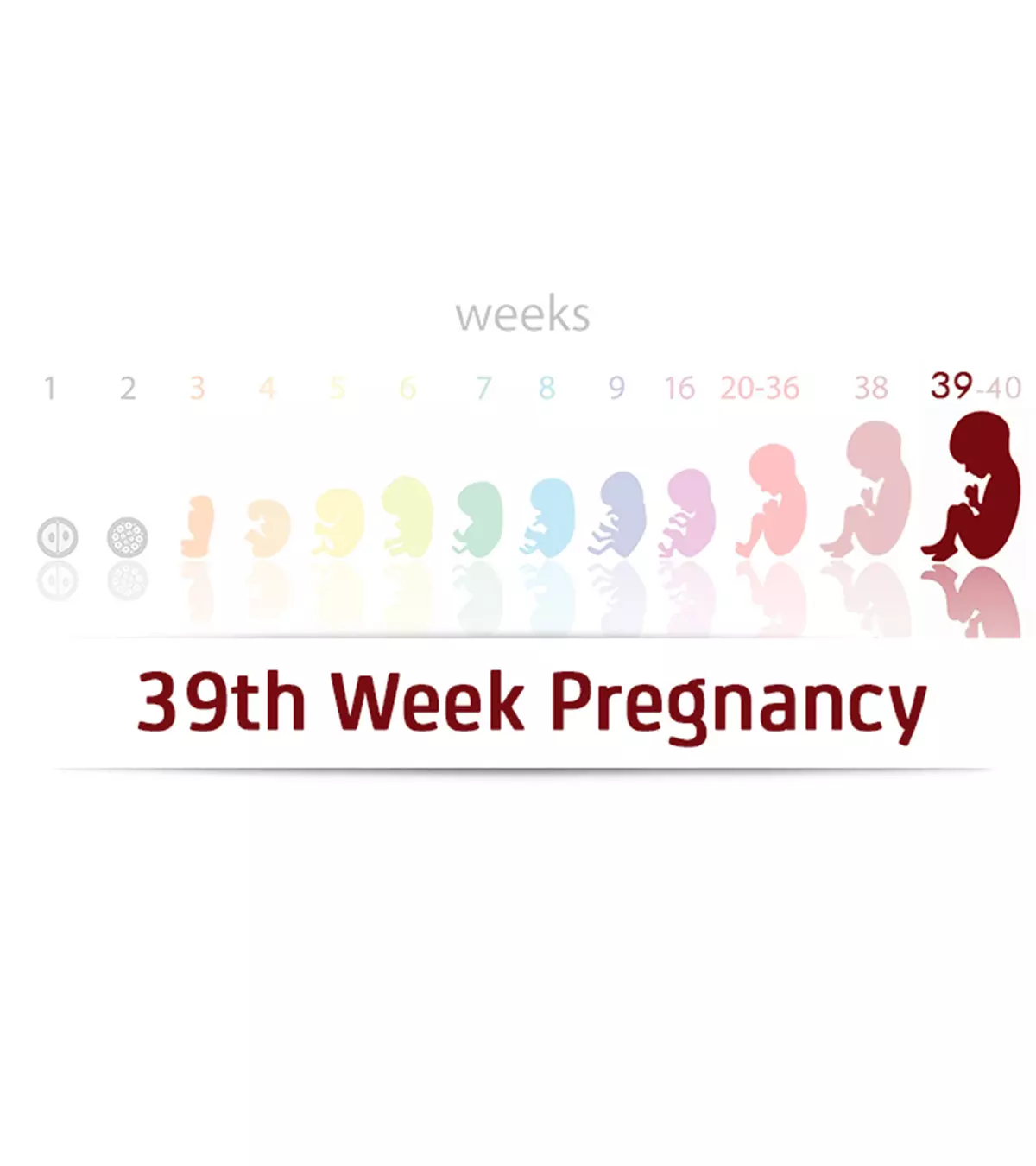
Image: Shutterstock

Key Pointers
- Baby’s length is 18-20 inches and weight is approximately seven pounds at 39 weeks.
- Reduced fetal movements occur due to limited space for the baby to move.
- Experiences may include Bracton-Hicks contractions, bloody show, colostrum leakage, and mood swings.
- Signs of labor at 39 weeks include lightening, water breaking, painful contractions, mucus plug discharge, bloody show, and backache.
- Contact healthcare provider if you have unusual symptoms like bleeding, reduced fetal movement, or fever.
How Many Months Pregnant Are You At 39 Weeks?
At 39 weeks, you are eight months and three weeks pregnant. The baby is considered full-term now, and the next week might be your due date.
In this post, Momjunction tells about fetal development, physical changes, and other aspects of maternal health that you will experience this week and shares prenatal care tips to stay healthy and happy.
How Big Is The Baby At 39 Weeks?
The baby is about the size of a mini watermelon (1). Babies usually measure 18 to 20 inches in length and around seven pounds in weight (2).
Baby Development At 39 weeks
The baby is fully developed by this week of pregnancy.
| Body parts | Development stage |
|---|---|
| Eyes (3) | Still developing |
| Brain (4) | Weighs one-third more than the fetal weight at 35 weeks |
| Lungs | Still developing |
| Liver | Continues to develop |
| Skin | Fat deposition continues under the skin layer to keep the fetus warm |
| Vernix (5) | The coating over the skin is completely gone. Some might be left under the arms, chin and in the elbow creases |
| Digestive system | Completely developed and contains meconium (baby’s first poo) |
| Gender | In boys, the testicles are completely descended into the scrotum |
| Umbilical cord (6) | Around 20 to 24 inches long |
The baby is almost grown by this week. As you are just a few days away from your due date, the baby prepares itself for labor by attaining the right position inside the womb. Here is a general overview of fetal position and movements during the 39th week.
Fetal Movements And Position At 39 Weeks
Baby’s Movements:
As the baby is fully grown now, there will not be sufficient space for proper movements. You may notice a reduction in the number of movements. However, if the movements reduce more than normal, check with your healthcare provider (2).
Position: The baby attains the head-down position with its face toward your spine. This is the optimal position for childbirth. If the baby attains a head-down position facing your abdomen, then it is called the occiput posterior position. This position can prolong the labor and make childbirth difficult (2).
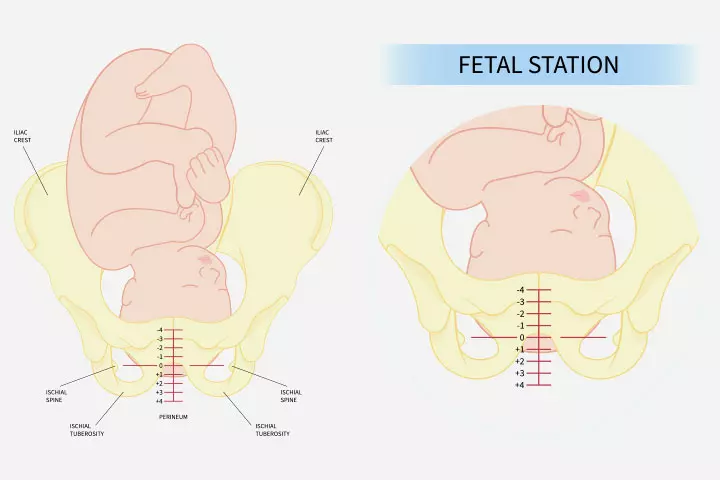
In some cases, the baby may be in a breech position, wherein it lies in a head-up and bottom-down position. Sometimes the baby may turn to the correct birthing position just before the onset of labor, but, in some cases, it may not happen and childbirth usually requires obstetric intervention.
The symptoms you experience this week are more or less the same as those you have been experiencing in the last few weeks of the third trimester.
What Symptoms Would You Experience In The 39th Week?
Here are the symptoms you may notice during this week of pregnancy (7):
- Braxton Hicks contractions: Cramping and tightening of the uterus are common in this week. It’s irregular and less painful and is the body’s way to prepare for labor and delivery (4).
- Pelvic pressure: As the baby drops down into the pelvis, some amount of pressure and pain are felt in the pelvic area.
- Lightning crotch: The baby’s head or shoulders can put pressure on the sensitive nerve, making you feel a sharp pain in the pelvis.
- Vaginal discharge: Thick and mucus-like discharge from the vagina indicates cervical dilationiOpening of the cervix, allowing the baby to pass through the birth canal .
- Trouble sleeping: Third-trimester pregnancy discomforts, maternal fatigue, aches, and restlessness make your sleep difficult. As per a study published in the Journal of Sleep Research, the prevalence of insomnia symptoms was higher in the third trimester (39.7%).

- Bloody show: You might have vaginal discharge tinged pink or brown, called a bloody show. The blood results from small ruptures of cervical blood vessels during effacement and dilation.
- Heartburn: The expanding uterus pushes the gastric acids upwards, towards the esophagus, causing heartburn.
- Frequent urination: The urge to urinate increases due to the pressure put by the uterus on the bladder.
- Diarrhea: Hormonal fluctuations could be a reason for diarrhea.
- Hemorrhoids: The pressure put by the enlarging uterus and increased blood flow towards the pelvic area cause the veins in the rectal region to swell.
- Backaches: The extra pressure that the baby puts on the lower back can cause a backache.
- Colostrum: The breast starts leaking the milk, called colostrum, the first milk that your baby will feed on.
The physical and emotional changes take a toll on you during this week, and you may be looking forward to ending this journey as soon as possible.
Changes In The Body At 39 Weeks
Physical changes
- The belly looks bigger and lower as the baby has attained full growth by this time and will be deep in the pelvis.
- The breasts are enlarged and the areola becomes darker.
- The skin is sensitive and itchy. Applying a moisturizer can help relieve the itchiness to some extent (7).
Emotional changes
- Anxiety, as you could be thinking about the imminent delivery and the well-being of the baby.
- Mood swings due to hormonal fluctuations.
- The postpartum planning and nesting instincts develop as you begin preparations for welcoming the new member (8).
Julia Goolia, a mother of three, expresses her anticipation and anxiety during her third pregnancy. She remembers, “Lots of really scary things can happen in labor and delivery. The anxiety and fear are creeping in just a smidge now that we are so close to D-day. I don’t like that panicky feeling, FYI … ‘Today could be the day’ is the most annoying thought in the entire world, and yet I can’t seem to stop it from overtaking my brain. Every. Day (i).”
Since you are closer to the due date, you might experience symptoms of labor. Know how to identify them.
Signs Of Labor In The 39th Week
Here are the signs of labor you must look out for during this week (7):
- Lightening, when you feel the baby drop down into the pelvis.
- Water breaking, with a constant water leak or a gush of amniotic fluid.
- Painful and frequent contractions at regular intervals.
- Discharge of a thick mucus plug from the vagina.
- Bloody show, an increased vaginal discharge tinged pink or bloody in color.
- Low, dull backache.

- Cramps with or without diarrhea.
In any case of medical conditions like gestational diabetesiA condition characterized by elevated blood sugar levels due to hormonal and physical changes in pregnancy , preeclampsiaiA severe pregnancy condition of high blood pressure and protein in the urine , problems with the placenta, or uterine infections, the doctor may suggest labor induction this week.
When To Call The Doctor?
Call the healthcare provider right away if you notice any unusual symptoms like (8):
- Bleeding, as you would during a menstrual period
- Reduced movement of the baby
- Slowed fetal movement for 24 hours
- Waters break (also called rupture of membranes)
- Regular or stronger contractions
- Fever
- Blurred vision
- Fainting or dizziness
- Pain in the belly or chest
- Sudden puffiness of hands or face
- Sudden onset of a headache
If there have been no signs of labor, then there is no need to worry. However, make sure to closely monitor the changes in your health, and do not miss your regular doctor’s appointment for the week.
 Be watchful
Be watchfulYour OB/GYN Visit
During your visit, the doctor will:
- Check your weight and blood pressure.
- Advise a urine test to check the sugar and protein level.
- Measure the height of the uterus to ascertain your baby’s growth.
- Check the fetal heart rate.
- Perform an ultrasound to check the fetal position in the womb. In the case of twin pregnancy, the ultrasound will be done to check the well-being of the babies (9).
- Ask questions regarding the fetal movements, C-section, labor induction, health issues, and about VBAC (vaginal birth after cesarean, if it is not your first delivery).
Take care of yourself and your health.
Tips To Follow
Here’s what you can do to stay healthy and comfortable this week.
- Moderate exercises like walking help you stay active and energetic. Kegel exercises and squatting are great to strengthen the pelvic muscles.
- Get enough rest.
- Consume additional 450 calories daily to meet increased energy needs during the third trimester (10). Incorporating nutrient-dense foods such as leafy greens, whole grains, and lean proteins can further support your health and your baby’s growth.
- Stay calm and keep stress at bay.
- Practice breathing exercises.
- Spend quality time with your partner, family, and friends and seek help from them.

- Wear comfortable and loose clothes.
- Wear flats and slippers.
- Sleep on your side and avoid sleeping on your back.
Just as you are, your partner must also be anxious about the delivery of the child. Next, we look at how he can support you in labor preparation and lessen the anxiety.
 Quick tip
Quick tipTips For Dad-To-Be
Here are some tips for the dad-to-be to follow this week (13):
- Keep all the important documents like insurance ready before your partner goes into labor.
- Listen to the doctor’s instructions and act wisely as she enters labor.
- Try to understand her preferences regarding delivery.
- Inquire about the hospital policies and the way they address patients.
- Make sure that the maternity bag has all the essential items.
- Make a list of emergency contact numbers of friends and family. It can help her reach out to them in your absence.
Make a list of emergency contact numbers of friends and family. It can help her reach out to them in your absence.
 Quick tip
Quick tipFrequently Asked Questions
1. Is the 39th week safe for delivery?
Yes, the 39th week is safe for delivery. At 39 weeks, your baby is completely developed, and your doctor may advise inducing labor during this week, depending on your and your baby’s health (11).
2. Will my doctor induce me at 39 weeks, if I ask?
Induction of labor at 39 weeks depends on the number of fetuses you are carrying, your and your fetus’s health, and the term of your pregnancy. Hence, you may discuss the induction, but your doctor must examine all the above aspects before proceeding (12).
3. How can I make my cervix open faster?
The different methods of cervical ripening or dilation include (13) (14):
- Medical ripening: Medicines such as misoprostol, vaginal inserts, and endocervical gels
- Mechanical ripening: Use of foley catheteriA flexible tube typically used for drainage of urine from the bladder or fingers
- Natural ripening: Acupuncture, castor oil, sexual intercourse, and herbal supplements
Remember to consult your Ob/Gyn about the safety of the above procedures before proceeding with it.
4. What should I pack in my hospital bag for delivery?
Prepare your hospital bag with comfortable clothing, basic toiletries, your birth plan, and essentials for the baby, like a going-home outfit. Include snacks, water, entertainment, and important documents like your ID and insurance to stay organized and at ease during labor.
Your baby is fully developed during the 39th week of pregnancy, and your body prepares for delivery. Usually, the next week, that is, the 40th week of pregnancy, is when a normal delivery is expected. However, you may go into labor during the 39th week in some cases. During this period, you may also experience false contractions, making it difficult for you to identify the real ones. Hence, we hope that the signs of labor mentioned above will be helpful. We would also recommend staying alert for any discomforts during this period and keeping your doctor up-to-date on the labor process.
Infographic: When To Call A Doctor During 39th Week Of Pregnancy?
As you enter the 39th week of pregnancy, your baby is attaining full-term, so it is essential to know when to seek medical care. In this infographic, we’ve provided certain signs and conditions that warrant you to call a doctor or visit a hospital. Knowing these signs will help you to have a safe pregnancy and childbirth.

Illustration: Momjunction Design Team
Illustration: 39th Week Pregnancy: Signs Baby Development & Fetal Movement

Image: Stable Diffusion/MomJunction Design Team
As you prepare for the arrival of your little bundle of joy, consider watching this video on what to expect as you reach 39 weeks of pregnancy. Equip yourself with all the required things and start making your journey toward the delivery room.
Personal Experience: Source
MomJunction articles include first-hand experiences to provide you with better insights through real-life narratives. Here are the sources of personal accounts referenced in this article.
i. Baby #3: 39 weeks.https://julia-transition.blogspot.com/2014/07/baby-3-39-weeks.html
References
- 39 Weeks Pregnant – All You Need To Know.
https://www.tommys.org/pregnancy-information/im-pregnant/pregnancy-week-by-week/39-weeks-pregnant - 39 Weeks Pregnant.
https://www.nhs.uk/start4life/pregnancy/week-by-week/3rd-trimester/week-39/ - Why At Least 39 Weeks Is Best For Your Baby?
https://www.marchofdimes.org/find-support/topics/birth/why-least-39-weeks-best-your-baby - Let Baby Set The Delivery Date.
https://newsinhealth.nih.gov/2013/09/let-baby-set-delivery-date - 39 Weeks Pregnant.
https://raisingchildren.net.au/pregnancy/week-by-week/third-trimester/39-weeks - Prenatal Summary.
https://www.ehd.org/prenatal-summary.php - When Does Labor Usually Start?
https://www.nichd.nih.gov/health/topics/labor-delivery/topicinfo/start-of-labor - Maternity.
https://www.beaumont.org/conditions/pregnancy-warning-signs - What Is The Optimal Gestational Age For Twin Delivery?
https://www.ncbi.nlm.nih.gov/pmc/articles/PMC1397866/ - Healthy Weight During Pregnancy.
https://www.eatright.org/health/pregnancy/prenatal-nutrition/healthy-weight-during-pregnancy#:~:text=Calorie%20Intake,calories%20a%20day%20when%20expecting. - For Healthy Pregnancies, Inducing Labor at 39 Weeks Is Safe.
https://www.cuimc.columbia.edu/news/healthy-pregnancies-inducing-labor-39-weeks-safe#:~:text=Babies%20are%20%E2%80%9Cdue%E2%80%9D%20after%2040 - Induction of labor at 39 weeks.
https://www.acog.org/womens-health/faqs/induction-of-labor-at-39-weeks - Cervical ripening methods when induction is part of the birth plan.
https://utswmed.org/medblog/cervical-ripening-techniques/ - Cervical Ripening.
https://my.clevelandclinic.org/health/procedures/22165-cervical-ripening
Community Experiences
Join the conversation and become a part of our nurturing community! Share your stories, experiences, and insights to connect with fellow parents.
Read full bio of Jacky Bloemraad-de Boer
Read full bio of shreeja pillai
Read full bio of Rebecca Malachi
Read full bio of Aneesha Amonz






